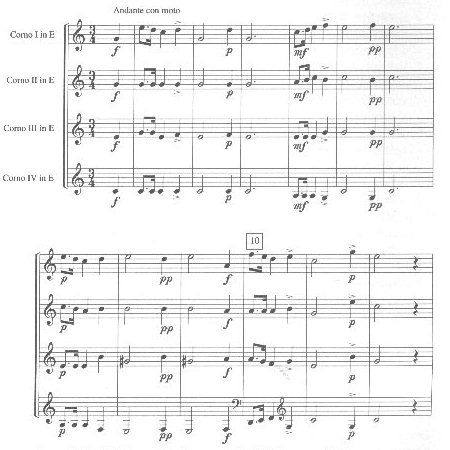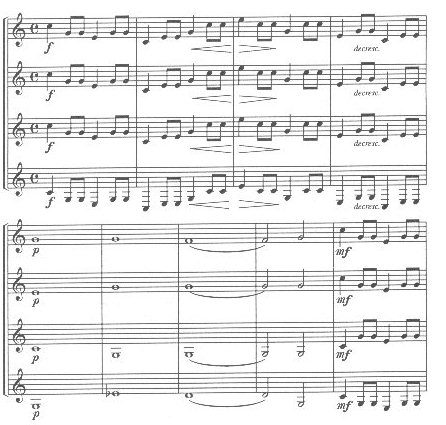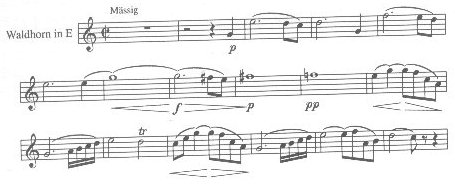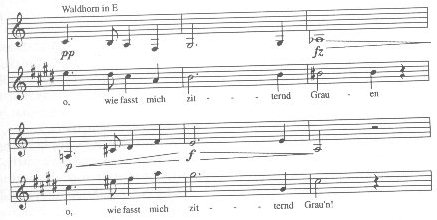Schubert and the Lewy BrothersImportant Works from 1827 and 1828. John EricsonThis article is based on materials published in The Horn Call Annual 8 (1996). Background biographical information on both Eduard Constantin Lewy (1796-1846) and Joseph Rudolphe Lewy (1802-1881) may be found in these articles: E. C. Lewy and Beethoven's Symphony No. 9 and in J. R. Lewy and Early Works of Wagner. The brothers E. C. and J. R. Lewy were among the most active of the very early valved horn performers. Of the pieces performed by the brothers together in this period in their numerous recitals, certainly the most notable work is the Nachtgesang im Walde, D. 913 of Franz Schubert. This work was composed specifically for performance by the Lewy brothers and gives a clear glimpse of their horn technique. Nachtgesang im Walde is for a quartet of men's voices (TTBB) and four horns. It was composed in 1827 for an April 22nd benefit concert organized by the Lewy brothers. Performing on the premiere were vocalists Eichberger, Ruprecht, Preisinger and Borschitzky, along with hornists Janatka, Leeser and the Lewy brothers [Deutsch, Reader, 631]. As the probable low hornist of the family, it seems likely that E. C. Lewy performed the fourth part on this work (J. R. Lewy made his career as a high horn player and possessed a very wide range). The performance received the following review in the Theaterzeitung on May first, 1827: Besides, much pleasure was given by a new composition by our ingenious vocal poet Franz Schubert. He set to music a poem by Johann Gabriel Seidl, 'Night Song in the Forest' ['Nachtgesang im Walde'], for four male voices, which he had accompanied by four obbligato horns. The difficulty of this, no doubt, lay in the distribution of effects and in the danger of either letting the vocal parts be drowned or degrading the accompaniment to a superfluous extra. The richly imaginative tone-poet successfully avoided both, and his tone-picture, performed in more suitable surroundings, at a serenade in the open air, should be enchantingly effective [trans. in ibid]. Unfortunately no contemporary concert review makes any mention of the valved horn being used in early performances of Nachtgesang im Walde. The major source to consider then are the horn parts themselves. The four horn parts of Nachtgesang im Walde are in E and are physically taxing. The opening is as follows: Example 1. Schubert, Nachtgesang im Walde, mm. 1-11. On the basis of technical considerations it would appear that Schubert called for a combination of natural and valved horns in this work. The opening section is typical of the writing and will serve as a representative example. The first three parts are easily playable on the natural horn, requiring the use of some hand-horn technique, but the fourth part is very awkward, requiring far too many heavily stopped notes to sustain the bass line. The low D on the downbeat of measure 10 would be particularly awkward, as this note would be very weak and unstable on the natural horn, and the note must be played very solidly as it is the root of the chord. This pitch is required numerous times of the fourth horn in this work. While all the notes requested in this work, even in the fourth horn, were possible on the natural horn and would have been practiced by every low horn player, these low range pitches were not typically used in this manner. It is highly unlikely that Schubert would have requested written D used in this manner of the natural horn. Nevertheless, it does seem likely from the writing that several of the other parts are intended for performance on the natural horn. Supporting this view is the following example from later in the work: Example 2. Schubert, Nachtgesang im Walde, mm. 182-190. Note that in measures 185-187 (and again when the phrase is repeated in measures 193-196) the third and fourth horn parts cross, and the fourth horn jumps to a written e-flat' and d'. These two pitches were never requested from the higher horns, but were asked of the fourth horn several times (the third and fourth parts also cross in measure 75, with the fourth horn again jumping up to d'). The d' in particular would be performed fully stopped on the natural horn, and thus would not be easily heard in the chord due to the decreased projection. Played on the valved horn, however, this pitch would lack nothing in terms of projection as it could be played as an open tone using the first valve. This voice crossing probably indicates that the third horn was not a valved horn. There is one low E (old notation) to be found in the third horn part in measure 199. While certainly a weak pitch, this note doubles the fourth horn and would thus create no problems in the voicing of the chord if taken on a natural horn. In fact, Schubert requested the same written E of the natural horn previously in his Symphony in B minor ("Unfinished") in 1822, showing that he felt the note was possible on the instrument [Blandford, 31]. Also notable in example 2, measure 186, is the crossing of the first and second horn parts; this could indicate that the first horn part was also written for the valved horn, avoiding placing the requested fully stopped f' in the second horn, which would appear to be for the natural horn. The first part was likely intended for performance by J. R. Lewy, and although the f' in question is easily playable on the natural horn, it would lie better on the valved horn and could be taken as a open tone with the first valve. From these representative passages it seems possible that Schubert conceived the work for at least one valved horn on the fourth part and three natural horns, and very likely two valved horns and two natural horns. In a sense, the idea that he wrote the work for a combination of valved horns and natural horns is only speculation, as all of the parts would lie better on valved horns, if four valved horns were available. The exact composition of the group would likely have depended on the instruments available to the performers; certainly at least both of the Lewy brothers did have valved horns available to them. Given that this work was written by Schubert for the Lewy brothers, this work most likely reflects their ideas with regard to the technique of the valved horn in 1827. The instrument is used primarily as a fully chromatic instrument, with special advantages in both the low range and in avoiding stopped tones in general. The choice of the E crook is also significant, as this shows that this crook was used on the valved horn by the Lewy brothers. It is significant as well that in this work one can find no trace of evidence to suggest that the valves were intended to be used as crooking devices, as would later be seen in a few of the etudes of J. R. Lewy, published circa 1850. [see the article on the topic Works By J. R. Lewy, coming soon.] An important question which can not fully be answered from the valved horn writing seen in Nachtgesang im Walde is that of what kind of valved horns E. C. and J. R. Lewy were playing upon in 1827. It is known that many early valved horns only had two valves. The only pitch in this work which would require the third valve to perform it as an open tone is the written low D which occurs many times. The third valve would also be very useful in performing the numerous written a-flat/g-sharp's found in the fourth part, although this pitch can be performed as an open pitch by raising the g with the hand (this practice was clearly noted on the natural horn in the Domnich Méthode). Due to the structural nature of these pitches, it would certainly be better to play both pitches using a three-valved instrument. It is known that J. R. Lewy used a three-valved instrument by 1835 at the latest [Weber, 104-105], but for a skilled natural horn player such as E. C. Lewy it would have been of no great difficulty to obtain either of these pitches on a two-valved instrument, combining the valves with the lip and the hand in the bell. While this work probably does actually call for the use of an instrument with three valves, it is difficult to say this with a certainty from the music alone in any work of this period. Finally, while certainly not the first work ever written for the valved horn, Nachtgesang im Walde is probably the first work by a major composer to use the valved horn and is certainly remarkable among the works of Schubert. [NOTE: It should be noted that in addition to the original version discussed here several very effective arrangements of this work are available for eight part horn ensemble.] The artistry of the Lewy brothers must have impressed Schubert, as he would quickly feature the horn again in a new work. Schubert composed his famous song with horn obbligato, Auf dem Strom, D. 943 (1828) specifically for performance by the young J. R. Lewy [Deutsch, Thematic, 461]. In this work Schubert placed much greater demands upon the instrument. Not only was a much wider individual range called for (although never outside the range of the Cor basse), but the horn writing was also much more melodic. Was Auf dem Strom actually written specifically for the valved horn? This work has been cited as the first work by a major composer for the valved horn (for example, Morley-Pegge, 2nd ed., 106), but no contemporary source indicates that this work was composed specifically for the valved horn. The work opens as follows. Example 3. Schubert, Auf dem Strom, mm. 1-17. There is nothing in the opening section which would preclude performance on the natural horn. As with Nachtgesang im Walde, the central performing issue is that of producing all of the notes requested in the low range of the horn. The most difficult passage is the following. Example 4. Schubert, Auf dem Strom, mm. 129-135. When performed on the natural horn there are several low heavily stopped notes to be dealt with, the most difficult pitches being the written f, a, and c-sharp'. While difficult on the natural horn, the way in which these pitches are used by Schubert permitted effective performance: that is, the difficult heavily stopped notes in the low range passages are pianissimo and double the vocal line, and thus do not require a great deal of projection. [NOTE: For those interested in performing this work on the natural horn, it must be noted that an historically accurate instrument and mouthpiece is of great importance in obtaining these low, "factitious" notes, as greater flexibility of pitch is required than would be desired on horns and mouthpieces of more modern design]. Written a-flat is also requested in this passage; this note can be easily performed playing g and opening the bell very widely. With regard to range, the work is primarily written in the middle range of the horn, with the exception of the last pitch of the work, written C. While more suitable for a Cor basse, the work could also have been performed by a high horn player of the period with a good low range. Judging from his later etudes, J. R. Lewy must have had a very wide range and would have had no trouble performing this work. While he made his career as a high hornist, it would appear that he was a strong performer in both ranges. A final question is the possibility of the horn writing in this work being idiomatic for the horn with two valves. A performer of Auf dem Strom does not need more than two valves to play every written pitch as an open tone. The only pitch seen outside of those available with true fingerings on the two-valved horn is a-flat, and this pitch can be performed either by raising the g with the hand or by lowering the a with the hand. Thus, this work is easily playable on the two-valved horn, and it is possible that this is the type of instrument that J. R. Lewy actually used in this period. While everything in this 1828 work is playable on the natural horn, it has already been noted that J. R. Lewy was performing on the valved horn by 1826. Auf dem Strom lies very well for the valved horn crooked in E, the same instrument that Schubert had called for in Nachtgesang im Walde. It is not known whether J. R. Lewy performed this work on the valved horn or the natural horn, but it seems likely that he would use the new instrument in performances of this new work. It would appear, however, that Schubert did not want to commit himself to the new instrument, and wrote Auf dem Strom in a way that it would still be playable on the natural horn. So while perhaps easier to perform on the valved horn crooked in E, it has been demonstrated by modern natural horn artists that Auf dem Strom can be performed very successfully on the natural horn. SOURCES W. F. H. Blandford, "Studies on the Horn. III. The Fourth Horn in the 'Choral Symphony,'" part 1, The Musical Times 66 (January 1, 1925), 29-32. Otto Erich Deutsch, The Schubert Reader (New York: W. W. Norton, 1947), translated by Eric Bloom. ________, Schubert: Thematic Catalogue of all His Works (London: J. M. Dent & Sons, 1951). Gottfried Weber, "Ueber Ventilhorn und Ventiltrompete mit drei Ventilen" [Valved Horn and Valved Trumpet with Three Valves], Cäcilia 17 (1835), 73-105. Copyright John Ericson. All rights reserved. |



